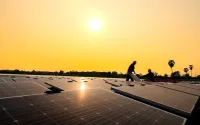6 April 2007
 |
Projected reductions in the area suitable for growing crops, and in the length of the growing season, are likely to produce an increased risk of hunger. In some countries, yields from rain-fed agriculture could be reduced by up to 50% by 2020.
Rising sea levels threaten large cities. Degradation of coral reefs and mangroves is likely, with impacts on local fisheries and tourism.
Rising temperatures, coupled with over-fishing, will decrease the supply of fish from large lakes, with important impacts on food supplies.
ASIA
 |
Economic development is likely to be impacted by the combination of climatic change, urbanisation, and rapid economic and population growth.
Forecast changes in temperature and rainfall are likely to reduce crop yields overall, increasing the risk of hunger.
The presence of lethal diarrhoeal diseases associated with floods and droughts is expected to rise in East, South and Southeast Asia and rises in coastal water temperature could exacerbate cholera in South Asia.
 |
Ecologically important regions such as the Great Barrier Reef and Kakadu National Park are likely to lose a significant part of their wildlife before then, by 2020.
Some coastal communities are very likely to see an increased risk of coastal storms and flooding.
Temperature rises of 1C-2C are likely to bring benefits to cooler areas, such as New Zealand, in the form of longer growing seasons and reduced energy demand. Greater warming is likely to bring a net negative impact - such as increased risk of drought and fire.
 |
Nearly all European regions are expected to be negatively affected by some future impacts of climate change.
Central and Eastern European countries could face less summer rainfall, causing higher water stress. Health risks due to heat waves are expected to increase. Forest productivity is expected to fall and the frequency of peatland fires to increase.
Southern European countries are very likely to see reduced water supplies, lower crop production, more wildfires and health impacts from increased heatwaves.
Northern countries are likely to benefit from increased crop yields, forest productivity, and food supplies from the North Atlantic. By 2020, most areas of Europe are likely to see an increased flood risk.
 |
Drier areas are likely to see salinisation and desertification of agricultural land, with falling crop yields and livestock productivity reducing food security. However, soybean yields are likely to increase in temperate zones.
Sea level rise is very likely to bring flooding to low-lying regions such as the coast of El Salvador, Guyana and the Rio de la Plata estuary. Increasing sea temperatures are likely to impact coral reefs and south-east Pacific fish stocks.
Changes in rainfall patterns and the disappearance of glaciers are projected to significantly affect water availability for human consumption, agriculture and energy generation.
 |
Increases in problems with pests, diseases and forest fires are likely.
Cities with a history of heat waves are likely to experience many more, with potential health impacts, especially for the elderly.
Rising sea levels, severe weather and storm surges, combined with population growth in coastal areas, are very likely to increase economic losses.
 |
The depth of summer permafrost melting is likely to increase.
Changes to natural ecosystems are likely to impact migrating birds, mammals and higher predators adversely. Specific ecosystems and habitats are expected to be vulnerable, as climatic barriers to species invasions are lowered.
There are virtually certain to be both negative and positive effects on Arctic peoples. Detrimental impacts would include those on infrastructure and traditional indigenous ways of life while beneficial effects would include reduced heating costs and more navigable northern sea routes.
 |
Beach erosion and coral bleaching are likely to reduce tourism.
There is strong evidence that water resources in small islands are likely to be seriously compromised.
Increased invasion by non-native species is likely.
 |
Drought-affected areas will likely increase. Instances of extreme rainfall are likely to increase in frequency and intensity, raising the risk of floods. Increases in the frequency and severity of floods and droughts will have implications on sustainable development.
Water volumes stored in glaciers and snow cover are very likely to decline, reducing summer and autumn flows in regions where more than one sixth of the world population currently live.
 |
In the second half of this century, ecosystems on land are likely to become a net source of carbon rather than a net absorber. This extra carbon will amplify climate change.
Roughly 20-30% of species are likely to be at high risk of irreversible extinction if the global average temperature rises by 1.5-2.5C beyond 1990 levels. For increases in global average temperature exceeding 1.5-2.5C, there are very likely to be major changes in ecosystems which will adversely effect the environmental goods and services which humans use.
 |
At lower latitudes, especially the seasonally dry tropics, crop yield potential is likely to decrease for even small global temperature increases, which would increase risk of hunger.
Global agricultural production potential is likely to increase with increases in global average temperature up to about 3C, but above this it is very likely to decrease.
Increased frequency of droughts and floods would affect local production negatively, especially in subsistence sectors at low latitudes.
 |
It is likely that corals will experience a major decline due to increased bleaching and mortality due to rising seawater temperatures. Salt marshes and mangroves will also be negatively affected by sea-level rise.
Many millions more people are expected to be flooded every year due to sea-level rise by the 2080s, especially in densely populated and low-lying settlements which already face other challenges such as tropical storms or local coastal subsidence. The numbers affected will be largest in the mega-deltas of Asia, but small islands face the highest relative increase in risk.
 |
The most vulnerable industries, settlements and societies are those in coastal and river flood plains, those whose economies are closely linked with climate-sensitive resources, and those in areas prone to extreme weather events, especially where rapid urbanisation is occurring.
Poor communities can be especially vulnerable because they tend to be concentrated in relatively high-risk areas, have more limited coping capacities, and can be more dependent on climate-sensitive resources such as local water and food supplies. Where extreme weather events become more intense, the economic costs of those events will increase, and these increases are likely to be substantial in the areas most directly affected.
 |
This will have implications for child growth and development; increased deaths, disease and injury due to heat waves, floods, storms, fires and droughts, the altered burden of water-related diseases; the increased frequency of cardio-respiratory diseases due to higher concentrations of ground level ozone, and the movement of some infectious disease carriers into new regions. vectors.
Climate change is likely to have some mixed effects, such as the expansion and contraction of the range of malaria in different regions. In some places, climate change is likely to bring some benefits to health such as fewer deaths from cold exposure.






